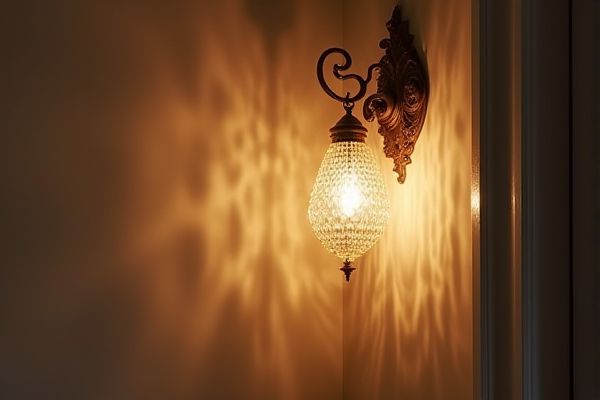
Sconce lighting offers subtle, wall-mounted illumination perfect for creating ambient moods, while chandeliers serve as bold, central fixtures that provide statement lighting and enhance room aesthetics. Explore the advantages of each to decide which lighting choice best complements your space and style.
Table of Comparison
| Feature | Sconce Lighting | Chandelier |
|---|---|---|
| Installation Location | Mounted on walls | Suspended from ceilings |
| Lighting Coverage | Ambient or accent lighting for small areas | Primary lighting for large rooms |
| Design Style | Minimalistic to decorative accents | Elegant and statement centerpiece |
| Space Requirements | Ideal for narrow or small spaces | Needs ample ceiling clearance and room size |
| Energy Efficiency | Generally uses fewer bulbs, lower power | Multiple bulbs, higher energy consumption |
| Cost Range | Affordable to mid-range | Mid-range to high-end pricing |
| Maintenance | Easy to clean and replace bulbs | Requires more effort due to size and height |
Introduction to Sconce Lighting and Chandeliers
Sconce lighting is a wall-mounted fixture providing ambient or accent illumination, ideal for enhancing room aesthetics and saving floor space. Chandeliers are ceiling-mounted fixtures that offer dramatic, central lighting often used as a focal point in dining rooms, foyers, or living areas. Both lighting options vary significantly in design, function, and placement, influencing ambiance and architectural style.
Design Differences: Sconces vs Chandeliers
Sconce lighting features wall-mounted fixtures that provide focused or ambient illumination with minimal space usage, often highlighting architectural elements or artwork. Chandeliers are ceiling-mounted fixtures designed to serve as central decorative pieces, offering expansive light diffusion through multiple arms and bulbs. Their design differences reflect varied spatial impacts: sconces create subtle, directional lighting while chandeliers establish dramatic, ambient illumination.
Functionality and Lighting Effects
Sconce lighting provides focused, ambient illumination ideal for highlighting specific areas or creating mood lighting along walls, whereas chandeliers offer centralized, decorative lighting that evenly disperses light throughout larger spaces. Sconces enhance architectural features and add subtle light without overwhelming the room, making them suitable for hallways, bathrooms, or accent lighting. Chandeliers serve as statement pieces that combine functionality with ornamental appeal, providing broad illumination that enhances the overall ambiance in dining rooms, foyers, or living areas.
Space Considerations for Each Fixture
Sconce lighting is ideal for smaller spaces or narrow walls, providing focused illumination without occupying floor or ceiling space. Chandeliers require more room, typically needing high ceilings and ample clearance to avoid overwhelming the area while serving as a central decorative element. Choosing between these fixtures depends on the spatial dimensions and desired lighting impact in the room.
Installation Requirements and Challenges
Sconce lighting typically requires minimal installation, often mounting directly to existing wall wiring, making it ideal for limited space or retrofit projects. Chandeliers demand more complex installation, involving secure ceiling mounting and suitable support for their weight, which can require professional electrical and structural work. Your choice depends on whether you prioritize ease and flexibility or dramatic impact and architectural enhancement.
Style Versatility in Interior Design
Sconce lighting offers flexible style options, easily fitting both modern and traditional interiors with subtle, wall-mounted designs that complement various decor themes. Chandeliers bring a bold, centralized statement, often serving as a focal point that enhances the elegance and grandeur of a room. Your choice depends on whether you want understated versatility or dramatic impact to define your interior's style.
Energy Efficiency Comparison
Sconce lighting typically consumes less energy than chandeliers due to its smaller size and fewer bulbs, making it a more efficient choice for ambient or task lighting. Chandeliers, often designed with multiple bulbs and larger fixtures, tend to use more electricity, which can increase your energy bills. Choosing LED bulbs for either option enhances energy efficiency and reduces environmental impact.
Maintenance and Longevity
Sconce lighting generally requires less maintenance than chandeliers due to its simpler design and easier access for cleaning and bulb replacement. Chandeliers, often larger and more intricate, demand regular dusting and occasional refurbishment to maintain their aesthetic appeal and functionality. The longevity of sconces is enhanced by their durable wall-mounted installation, while chandeliers may experience wear from hanging fixtures and frequent handling.
Cost Analysis: Sconces vs Chandeliers
Sconce lighting generally offers a more budget-friendly option compared to chandeliers, with average costs ranging from $50 to $300 per fixture, while chandeliers often start at $200 and can exceed $2,000 depending on size and materials. Installation expenses for sconces tend to be lower due to simpler mounting and wiring requirements, whereas chandeliers typically require professional installation and ceiling reinforcement, increasing overall costs. Your choice should consider both initial purchase and long-term installation expenses to optimize lighting investments.
Choosing the Right Fixture for Your Space
Sconce lighting offers focused illumination and space-saving benefits, ideal for narrow hallways or accentuating artwork, while chandeliers provide a dramatic centerpiece with ambient light suited for larger rooms or dining areas. Consider the room size, ceiling height, and desired lighting effect when selecting between sconces and chandeliers to enhance both functionality and aesthetic appeal. Proper fixture placement and style coordination ensure optimal lighting balance and elevate the overall interior design.
 homyna.com
homyna.com